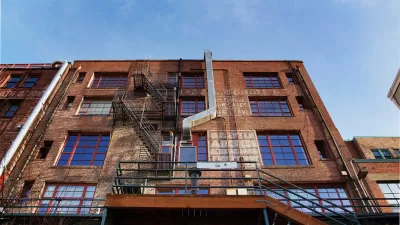Sunday's powerful Bay Area earthquake brought attention to the urgent need to retrofit existing buildings in California. One expert stated the damage in Napa "was predictable." Do you know the three types of construction that need to be reinforced?
"Experts have long known that three types of construction common in the state don't hold up well in quakes: brick or stone, those with "soft" stories—floors not well-reinforced—and certain kinds of concrete structures. In California, new construction of such buildings has been banned," writes Alejandro Lazo.
But such buildings haven't disappeared, and efforts to retrofit those remaining aren't uniform. The state leaves enforcement of such measures in the hands of local jurisdictions.
Lazo describes the retrofit required for each type of aforementioned construction. Napa had passed a 2006 ordinance requiring retrofit of unreinforced masonry. All but about six of these types of buildings had undergone retrofit when the quake hit.
Building damage was widespread nevertheless. "On Monday (August 25), the city of Napa said that 64 buildings had been tagged 'red' by inspectors as unsafe to enter. More than 100 were tagged 'yellow, meaning they require further inspection," notes Lazo.
Lucile Jones, a seismologist with the U.S. Geological Survey, who has been hired by the city of Los Angeles to evaluate its buildings, said the structural damage from Sunday's quake "was extremely predictable." Dr. Jones, who advises the state commission on risk reduction, added: "We now have to make a choice to do something about it before the next earthquake hits."
Correspondent's note on access to Wall Street Journal article: Subscriber-only content will be available to non-subscribers for up to seven days after August 26.
FULL STORY: Quake Raises Building-Safety Questions

Maui's Vacation Rental Debate Turns Ugly
Verbal attacks, misinformation campaigns and fistfights plague a high-stakes debate to convert thousands of vacation rentals into long-term housing.

Planetizen Federal Action Tracker
A weekly monitor of how Trump’s orders and actions are impacting planners and planning in America.

In Urban Planning, AI Prompting Could be the New Design Thinking
Creativity has long been key to great urban design. What if we see AI as our new creative partner?

King County Supportive Housing Program Offers Hope for Unhoused Residents
The county is taking a ‘Housing First’ approach that prioritizes getting people into housing, then offering wraparound supportive services.

Researchers Use AI to Get Clearer Picture of US Housing
Analysts are using artificial intelligence to supercharge their research by allowing them to comb through data faster. Though these AI tools can be error prone, they save time and housing researchers are optimistic about the future.

Making Shared Micromobility More Inclusive
Cities and shared mobility system operators can do more to include people with disabilities in planning and operations, per a new report.
Urban Design for Planners 1: Software Tools
This six-course series explores essential urban design concepts using open source software and equips planners with the tools they need to participate fully in the urban design process.
Planning for Universal Design
Learn the tools for implementing Universal Design in planning regulations.
planning NEXT
Appalachian Highlands Housing Partners
Mpact (founded as Rail~Volution)
City of Camden Redevelopment Agency
City of Astoria
City of Portland
City of Laramie





























